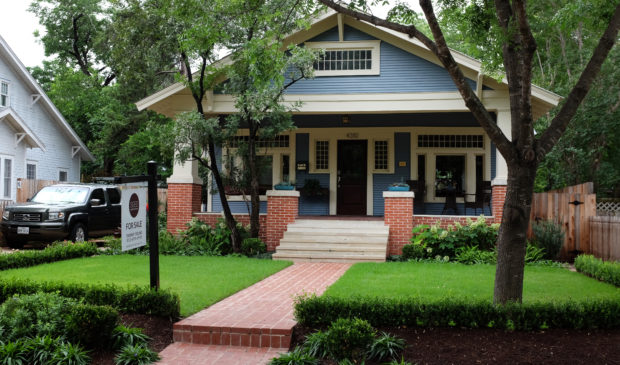In Hyde Park, residents question how CodeNEXT will be implemented
Tuesday, May 23, 2017 by
Syeda Hasan Since the city released its first draft of a new land development code earlier this year, residents and city leaders have been working to understand how it will shape Austin neighborhoods.
In Hyde Park, residents have adopted a tool that regulates development and aims to preserve the historic neighborhood’s character, but some say this exempts the area from having to follow the new code.
Walking along Avenue G, Hyde Park resident Pete Gilcrease pointed out buildings that could not be built in parts of the neighborhood today under current land use rules.
“This is a duplex,” Gilcrease said. “It’s on a smaller lot. It’s under 7,000 square feet.” and in Hyde Park the NCCD doesn’t allow two units unless you have more than 7,000 square feet.”
Gilcrease says in this part of Hyde Park, building two residential units on a single lot requires a minimum size of 7,000 square feet under the Hyde Park NCCD, or Neighborhood Conservation Combining District, is a custom zoning district that was adopted in 2002. This tool doesn’t come into play often. There are only six of these districts around Austin, but the city has put them in place to preserve older neighborhoods that were substantially built out more than 30 years ago.
To Gilcrease, the tool essentially exempts Hyde Park from the new development regulations, known as CodeNEXT. He takes particular issue with rules that require larger lots for duplexes and other multifamily developments known as “missing middle” housing. Gilcrease said under the NCCD, it’s easier to build large single-family homes on large lots.
“Only wealthier people would be able to afford a large piece of land to do that, and so even though it’s not intentionally segregationist, it has that same impact,” he said.
Gilcrease owns his home and has lived in Hyde Park for about seven years. He’s also a chair of the Friends of Hyde Park neighborhood association, which was formed in just the last few years. On the other side of this debate is the Hyde Park Neighborhood Association, which has been around since the 1970s. The group’s co-president Reid Long says the NCCD was crafted in accordance with the neighborhood plan to encourage responsible growth in areas that have the infrastructure to sustain added density. Long, who has been a renter in Hyde Park for about 10 years, doesn’t think that eliminating the NCCD is a blanket solution for increasing density.
“The tool itself can actually be used to encourage density, and so it’s about balancing what the infrastructure is able to withstand and what makes sense within the context of a growing and diversifying neighborhood,” Long said.
For example, Long said, the NCCD encourages commercial development along Guadalupe Street and in the area around the intersection of Duval and 45th streets. It also creates a buffer between commercial and residential, though Gilcrease said he would like to see more walkable amenities dispersed throughout the neighborhood.
Jorge Rousselin is a project manager on CodeNEXT. He explained why city staff chose to keep NCCDs in the new code.
“That already has a level of scrutiny, detail and nuance that essentially has already gone through an extensive public process, and at this time we didn’t feel that it was necessary to start to modify those NCCDs unless obviously (City Council) would give us direction to do otherwise,” Rousselin said.
Rousselin reiterated that CodeNEXT is still a work in progress. He welcomes people to weigh in at upcoming district meetings or to comment online. Council is slated to vote on adopting CodeNEXT in April 2018.
Curious about how we got here? Check out the Austin Monitor’s CodeNEXT Timeline.
This story has been corrected. We originally reported that Hyde Park does not allow multifamily construction on lots under 7,000 square feet but, in fact, the NCCD has varying requirements in different areas of the neighborhood.
This story was produced as part of the Austin Monitor’s reporting partnership with KUT. Photo by Jorge Sanhueza-Lyon/KUT News.
The Austin Monitor’s work is made possible by donations from the community. Though our reporting covers donors from time to time, we are careful to keep business and editorial efforts separate while maintaining transparency. A complete list of donors is available here, and our code of ethics is explained here.
You're a community leader
And we’re honored you look to us for serious, in-depth news. You know a strong community needs local and dedicated watchdog reporting. We’re here for you and that won’t change. Now will you take the powerful next step and support our nonprofit news organization?




